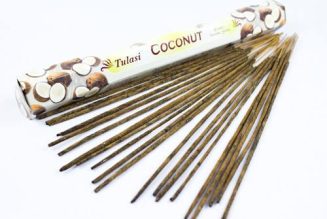Allspice, also known popularly as Jamaican pepper or pimento, is just what its name implies: a single spice that tastes like a mixture of cinnamon, nutmeg, ginger, and pepper, which adds spiciness to all dishes. The spice is enriched with the good amount of minerals like potassium, manganese, iron, copper, selenium, and magnesium. Also contains very good amounts of vitamin A, vitamin B-6 (pyridoxine), riboflavin, niacin and vitamin-C.
Anise has a strong licorice flavor, making its seed popular in cakes and cookies. Ground anise seed is used with fruit or cabbage. Star anise is a similar spice from Asia. A great source of minerals like calcium, iron, copper, potassium, manganese, zinc and magnesium. Also contains good amounts of anti-oxidant vitamins such as vitamin-C and vitamin-A.
Basil has a distinctive warm, minty flavor, and is most frequently used for pesto sauces and tomato dishes. It goes well with most Mediterranean-style dishes. Contains exceptionally high levels of beta-carotene, vitamin A, vitamin K, cryptoxanthin, lutein and zea-xanthin. Also contains a good amount of minerals like potassium, manganese, copper, and magnesium.
Bay leaf has a pungent woodsy flavor, and aroma that complements meats, soups, and stews. Add the dry, brittle leaf at the beginning of cooking to allow time for it to release its flavour. Remove leaf before serving. Good source of minerals like copper, potassium, calcium, manganese, iron, selenium, zinc and magnesium. Also contains vitamin A, vitamin C and folic acid.
Black peppercorns are sharp and aromatic. Freshly ground black pepper from a pepper mill gives the most flavor. Good source of many anti-oxidant vitamins such as vitamin-C and vitamin-A. They are also an excellent source of many vital B-complex groups of vitamins such as Pyridoxine, riboflavin, thiamin and niacin.
Caraway seeds, small and aromatic, have an anise-like flavor. They add that flavour and a nutty texture to breads, cakes, cheeses, vegetables, and meats. An excellent source of minerals like iron, copper, calcium, potassium, manganese, selenium, zinc and magnesium. Vitamin A, vitamin E, vitamin C as well as many B-complex vitamins like thiamin, pyridoxine, riboflavin, and niacin particularly are concentrated in the caraway seeds.
Cardamom comes from the ground seed of an Indian plant in the ginger family. It is a spice used mainly in curries and baking. Good source of minerals like potassium, calcium, magnesium, iron and manganese.
Cayenne, ground dried red chili peppers and their seeds, is hot and peppery in sauces and stews. Contains very high levels of essential minerals, iron, copper, zinc, potassium, manganese, magnesium and selenium. Also good in B-complex group of vitamins such as niacin, pyridoxine (vitamin B-6), riboflavin and thiamin (vitamin B-1).
Celery seeds, tiny as they are, can give a strong celery flavour to sauces, dips, stews, or soups. Good source of vitamin C. Also has antiseptic, anti-inflammatory and diuretic properties.
Chervil is an anise-tasting herb that enhances egg, chicken, shrimp, and salad dishes. Excellent source of Vitamins A and C, as well as calcium, iron, manganese, potassium and zinc. Chervil also contains smaller but significant amounts of a number of the B vitamins, magnesium, selenium, copper and phosphorous.
Chili powder, which comes in hot or mild versions, is a mixture of ground dried chilies, and other herbs, such as garlic, oregano, cumin, coriander, and cloves. Good source of vitamin C, vitamin A, and flvonoids like beta-carotene, alpha carotene, lutein, zeaxanthin, and cryptoxanthins. Contains good amount of minerals like potassium, manganese, iron, and magnesium.
Chives add a sweet onion flavor to salads, sauces, and dips. They are an easy perennial to grow, but also can be bought fresh, frozen, or freeze-dried at grocery stores. Contain vitamins such as vitamin C, and K, in fact; chives are one of the richest sources of vitamin K. The leaves are packed with other B-complex vitamins as well as some essential minerals such as copper, iron, manganese, zinc, and calcium. The leafy greens contain several vital vitamins such as pyridoxine, pantothenic acid, niacin, riboflavin, and thiamin in healthy proportions.
Cilantro, and coriander, refer to the same plant. Its fresh green leaves are very aromatic and distinct in their flavor, and are popular in Mexican and Southwest American dishes as well as Asian cooking. The ground seeds are used in curries and spice cakes. Good source of minerals like potassium, calcium, manganese, iron, and magnesium. Also contain vitamins including folic-acid, riboflavin, niacin, vitamin-A, beta carotene and vitamin-C.
Cinnamon comes in stick form (good for spicing up hot ciders) or ground (mix with sugar for cinnamon toast). Cinnamon flavors sweet rolls, spice cakes, and puddings. It is also used in Moroccan and Greek entrees and pilafs. Great source of manganese, fiber, iron and calcium.
Cloves are used to stud hams before baking or spike apples for a cider punch. Use ground cloves for spice cakes or puddings. Contains a good amount of minerals like potassium, manganese, iron, selenium and magnesium. This spice is a good source of vitamin-K, vitamin-A, vitamin-B6 (pyridoxine), thiamin (vitamin B-1), vitamin-C and riboflavin.
Cumin seeds and ground cumin have an earthy flavour that adds richness to Mexican, bean, and shellfish recipes. Good source of iron, vitamin C, vitamin A and essential oils.
Dill, either freshly chopped or dried dill weed, gives a fresh flavour to beets, carrots, cucumbers, pickled vegetables, potatoes, and seafood. Dill seed is used in pickling. Good source of minerals like copper, potassium, calcium, manganese, iron, and magnesium. Also contain folic acid, riboflavin, niacin, vitamin A, ß-carotene and vitamin-C.
Fennel seeds have an anise flavour that goes well with fish and pork. Great source of minerals like copper, iron, calcium, potassium, manganese, selenium, zinc, and magnesium.
Gingerroot has a sharp, lemony flavour. Fresh gingerroot is peeled and grated or diced and added to stir-fries or spicy stews. Store fresh ginger, well wrapped, in the freezer. Ground dried ginger is used in cakes and cookies as well as some curries. Good amount of minerals like potassium, manganese, copper, and magnesium.
Mace is the external covering, or aril, of the nutmeg seed that is also and ground for use as a spice. It is hotter and less subtle than nutmeg and a classic spice for pound cake. Good source of minerals like copper, potassium, calcium, manganese, iron, zinc and magnesium. Rich in many vital B-complex vitamins, including vitamin C, folic acid, riboflavin, niacin and vitamin A.
Marjoram has a spicy, fresh flavour that goes with most vegetables, especially those used in Mexican, Greek, and Italian recipes. One of the richest herbal sources for vitamin K. Also contains vitamin A and vitamin C. Good amount of minerals like iron, calcium, potassium, manganese, copper, zinc and magnesium.
Mint has a light, fresh taste that enlivens fruit drinks like lemonade and fruit salads; it also enhances the taste of lamb and fish. Contains good amounts of Vitamin A, C, B12, folic acid, thiamine and riboflavin, as well as, minerals such as, calcium, copper, fluoride, iron, manganese, phosphorus, potassium, selenium and zinc.
Mustard seed is used to make many popular commercial spreads from Dijon to hot dog mustard. Ground mustard seed, hot and pungent, is also an important ingredient in homemade mayonnaise, and many sauces and gravies served with fish, poultry, and meat. Rich source of many health benefiting minerals like, calcium, manganese, copper, iron, selenium and zinc. An excellent source of essential B-complex vitamins such as folates, niacin, thiamin, riboflavin, pyridoxine (vitaminB-6), pantothenic acid.
Nutmeg has a warm, sweet, nutty flavour that complements spinach, pumpkin, and cheese dishes as well as puddings. Good source of minerals like copper, potassium, calcium, manganese, iron, zinc and magnesium. Rich in many vital B-complex vitamins, including vitamin C, folic acid, riboflavin, niacin and vitamin A.
Oregano, like a stronger version of marjoram, enhances tomato, cabbage, poultry, beef, veal, and lamb recipes. An excellent source of minerals like potassium, calcium, manganese, iron and magnesium.
Paprika, like cayenne, is ground dried red peppers but in a combination that is milder and sweeter. Hungarian paprika is among the best, aromatic and delicious. Some paprika sold in Canada is so mild that it is used as decoration only. Good source of vitmains A, C, E and iron.
Parsley comes in two versions, curly-leaf and flat-leaf. The two kinds can be used interchangeably to add a fresh taste to potatoes, grains, mushrooms, and meat. Chewing fresh parsley is said to freshen the breath. One of the richest of the entire herb source for vitamin K. Good source of minerals like potassium, calcium, manganese, iron, and magnesium.
Red pepper flakes are made from crushed, dried chili peppers and are very hot. Use them to add hotness to chilies and stews.
Rosemary has an intense, earthy flavour that makes it especially good for marinades and grilled foods, such as lamb. Used sparingly (because it is strong), it complements beans, legumes, mushrooms, peas, summer squash, and zucchini. A rich source of minerals like potassium, calcium, iron, manganese, copper, and magnesium. An excellent source of iron, folic acid, vitamin A and vitamin C.
Saffron, the most expensive of all spices, is obtained from the stamens of a single variety of fall crocus. It is used to flavour—and color—rice, vegetable soups, fish dishes, and sweet rolls. Good source of minerals like copper, potassium, calcium, manganese, iron, selenium, zinc and magnesium. A rich in many vital vitamins, including vitamin A, folic acid, riboflavin, niacin and vitamin-C.
Sage has a woodsy, aromatic flavour that is often used in Italian cooking, blending well with garlic and tomatoes. It also goes well with onions, legumes, pork, poultry, and stuffing. Rich source of minerals like potassium, zinc, calcium, iron, manganese, copper, and magnesium. A very rich source of several B-complex groups of vitamins, such as folic acid, thiamin, pyridoxine, riboflavin, vitamin A and vitamin C.
Sea salt, such as fleur de sel from France and alaea from Hawaii, is literally taken from the sea; it’s what’s left when the water is evaporated. Depending on its source, sea salt has subtle flavours from trace minerals. It is coarse and should be sprinkled on food after cooking.
Summer savory is a slightly peppery herb that spices up green beans, dried beans, cabbage, Brussels sprouts, and potatoes as well as fish, poultry, and pork. A rich source of many important vitamins such as B-complex group vitamins, vitamin-A, vitamin-C, niacin, thiamin and pyridoxine.
Tarragon, a popular French herb, has an anise-like flavour that complements carrots, greens, chicken, seafood, and egg dishes. A rich source of vitamins such as vitamin-C, vitamin-A as well as B-complex group of vitamins such as folates, pyridoxine, niacin and riboflavin.
Thyme has a light, spicy flavour that marries well with carrots, mushrooms, and salad greens, as well as beef, pork, lamb, poultry, and oil-rich fish. It is especially tasty in soups, and stews. Its leaves are one of the richest sources of potassium, iron, calcium, manganese, magnesium, and selenium. A rich source of many important vitamins such as B-complex vitamins, beta caratene, vitamin A, vitamin K, vitamin E, vitamin C and folic acid.








